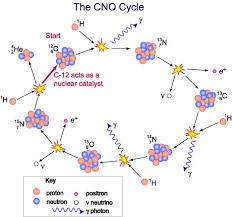Overview
The nuclear energy that powers stars depends upon the core temperature and the available fuel. During the main-sequence phase for most stars, nuclear fusion of 4 hydrogen atoms to form 2 helium atoms provides the most energy. Other types of fusion reactions occur in stars with higher core temperatures and when hydrogen fuel is exhausted.
The Structure of a Star
A star consists of superheated gaseous plasma that is held together by gravity. As interstellar gases condense, layers form around a central core. Gases are under the highest pressure there, and the energy ignites further reactions. Heat and energy are carried by convection and radiation to the outer layers, and beyond. Turbulence within the core mixes and carries elements throughout the core and to the zones beyond. Studies in particle physics, in the measurement of stellar spectra, and mathematical modeling of nuclear fusion reactions all contribute to the study of stellar structure.
The Proton-Proton Chain Reaction
The most common reaction in the sun and other stars is called the proton-proton chain reaction. It involves 4 hydrogen atoms, which contribute 4 protons. In the process 2 protons lose their charge, becoming 2 neutrons, gamma rays, electrons, and positrons, which spin off and release energy. The electrons and positrons (which are antimatter, after all) annihilate each other, releasing more energy. Other elements that are produced by the proton-proton chain include unstable isotopes of beryllium and lithium that decay rapidly and release more energy.
The Carbon-Nitrogen-Oxygen Reaction
Stars that have core temperatures of 12000 K to 15000 K have another type of nuclear reaction, called the carbon-nitrogen-oxygen reaction. Carbon, nitrogen, and oxygen are catalysts to the proton-proton chain reaction, and those heavy elements are also produced. In the largest, hottest stars (the blue and white main-sequence stars, as well as the heaviest and brightest supergiants), nitrogen is produced and helium is released, as well as energy in the form of gamma rays, neutrinos, electron-positron pairs, and other subatomic particles.
Helium Fusion
Helium fusion is also called the triple-alpha process. After the hydrogen in the stellar core is used up, the core collapses. The core collapse raises the temperature enough that helium nuclei fuse. Intermediate steps produce the elements beryllium, lithium, carbon, and some heavier elements. Although the hydrogen to helium process can be maintained for billions of years in main-sequence stars, helium fusion is more unstable. Stars lose their photospheres, and many explode. The most massive stars become supernovae.
Interested in science tutoring services? Learn more about how we are assisting thousands of students each academic year.
SchoolTutoring Academy is the premier educational services company for K-12 and college students. We offer tutoring programs for students in K-12, AP classes, and college. To learn more about how we help parents and students in Sioux City, IA: visit: Tutoring in Sioux City, IA





